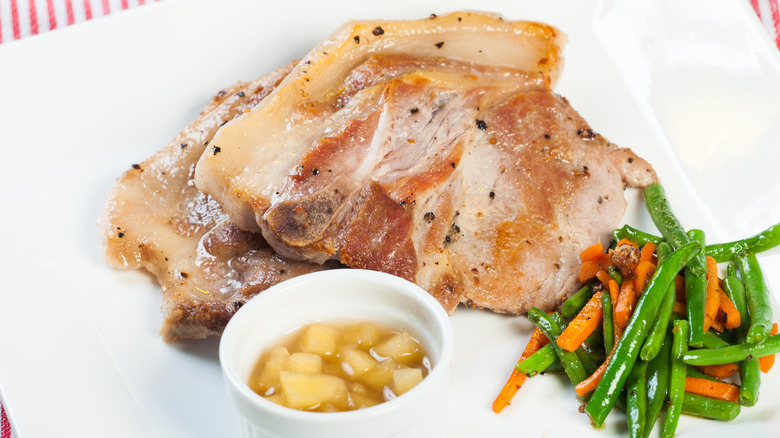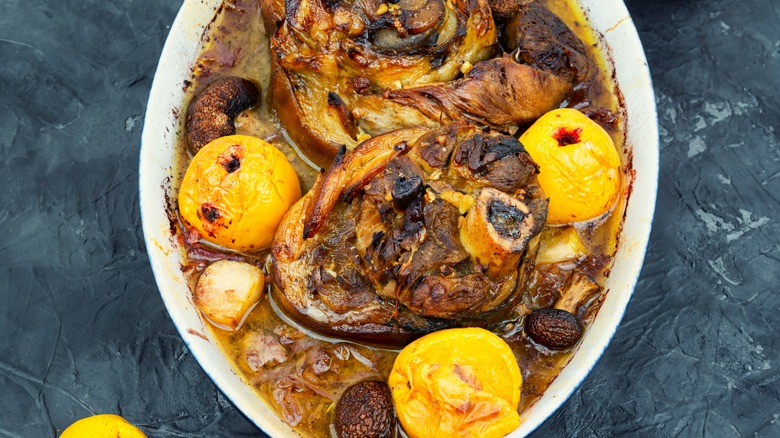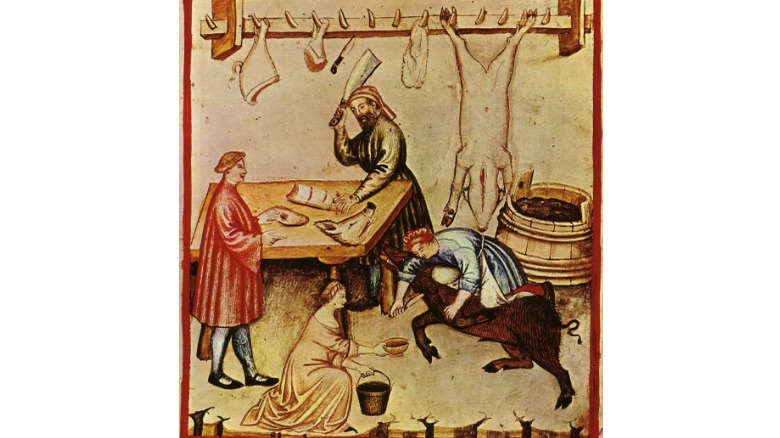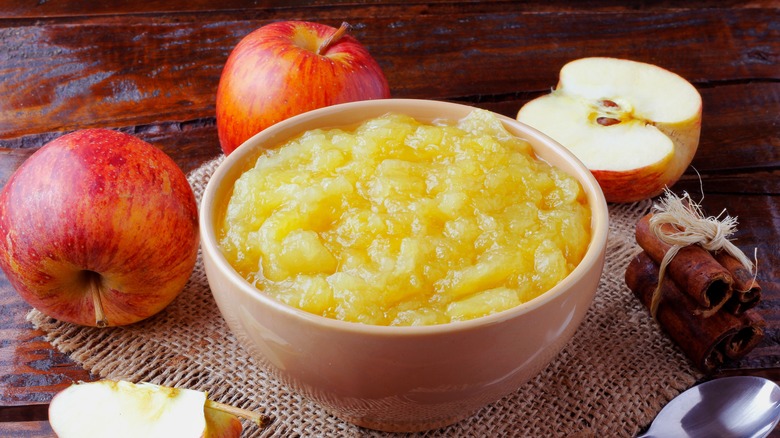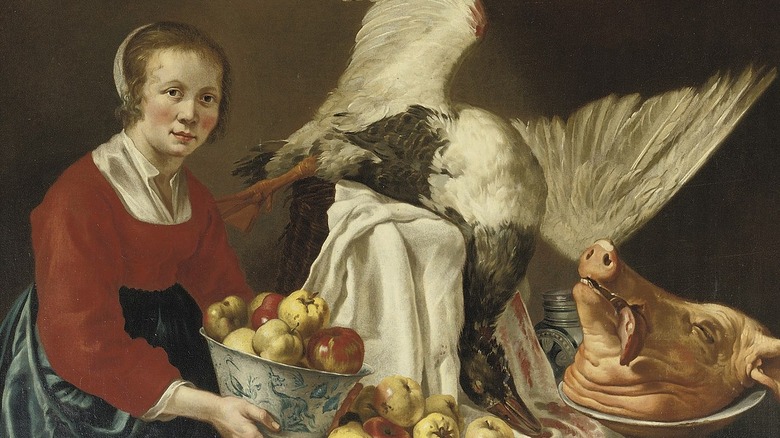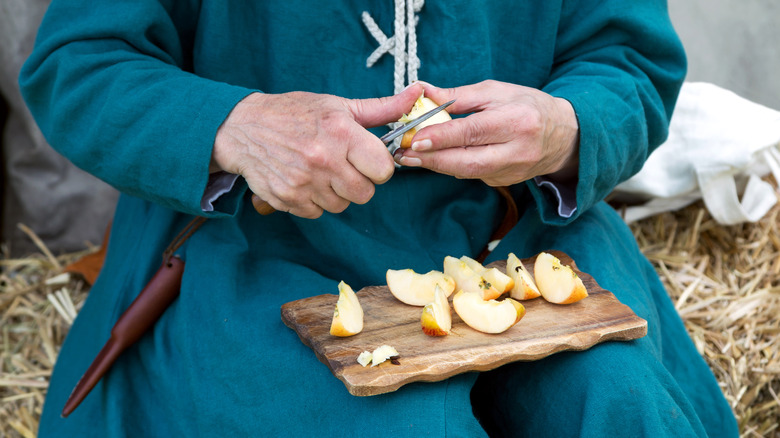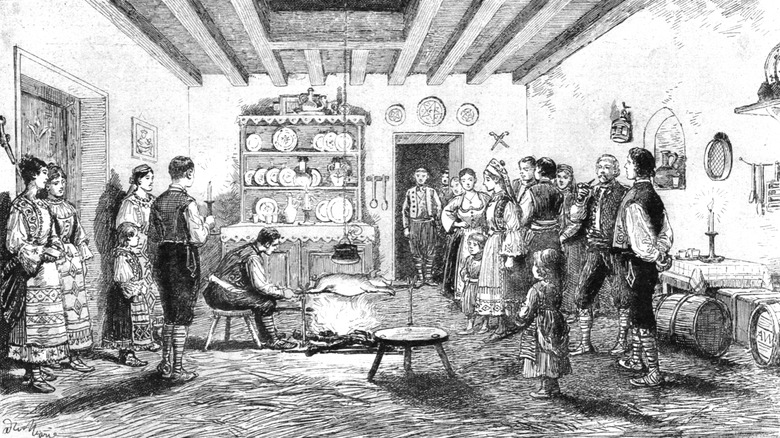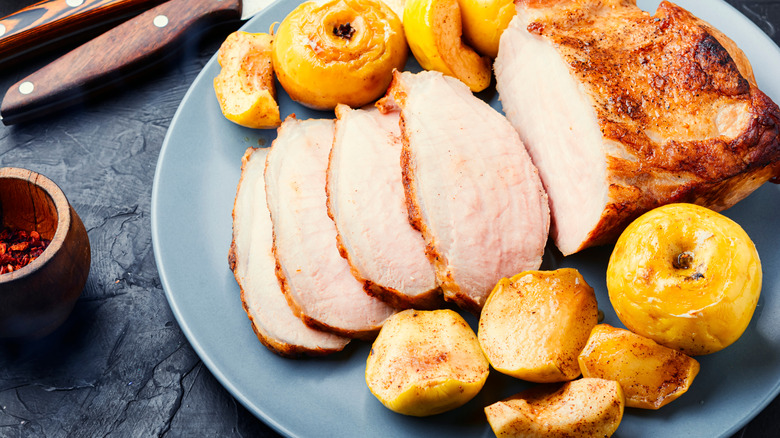The History Of Eating Pork And Applesauce
Cooking pork with apples could be one of humanity's most ancient recipes. This combination appears in some of the oldest known cookbooks. Even before that, though, long before humans invented writing, early inhabitants of Central Asia's Tien-Shan Mountains had access to both foods.
What is known today as Kazakhstan's Sairam-Ugam National Park is home to incredible fruit trees. Their DNA has shown that they are the ancestors of the modern apple. In the fall, yellow, red, and green fruit tumble from their branches to the forest floor. Wild boars roam the wooded slopes of this nature reserve. Early humans there could have easily sat around an autumn fire, sharing the day's bounty: apples plucked from branches and a roasted boar, hunted with a crude, rock-tipped spear. These hunter-gatherers didn't leave recipes on cave walls, though, and archaeologists can only deduce what they ate from clues left in rubbish piles. No one will ever know if they ever combined boar with apples.
Fortunately, the more recent ancient history of apples and pork is easier to decipher, since European cooks began recording their recipes from around the fourth or fifth century AD onward. The continent's earliest recipe collections paint the history of how cooks stewed apples and pork together, and sometimes crushed the fruit into sauces.
Apple and pork stew: minutal matianum - 50 BC to 400 AD
Marcus Gavius Apicius may have been the world's first foodie and inventor of pork and apple stew. The Roman merchant lived in the first century A.D. and sought out the most delicious foods in the world. Legend has it he once sailed from Rome to Libya just to try particularly delicious shrimp.
History lost the first manuscripts in which Apicius recorded his recipes, but some time in the fourth century, a scholar compiled them (before losing them) into "De re coquinaria" or "The Art of Cooking" also known as "Culinary Matters." Among the 400 recipes in the collection appears "Minutal Matianum," a stew made from pork and apples. It also calls for oil, leeks, coriander, pepper, cumin, mint, laser, and vinegar. The final product of pork morsels drizzled with the juices of the stew is mouthwatering.
Apicius may not have been the first to prepare this delectable dish, though. Since it's called Minutal Matianum, some historians believe that the recipe is named for Gaius Matius — note the resemblance of Matianum to this cook's last name. Matius, who lived during the reign of Julius Caesar, around 50 BC and about 100 years before Apicius, may have written two or three cookbooks. Scholars suspect that most of Matius' recipes didn't survive to the modern day, but the one that appears in Apicius's book did. On the other hand, Matianum could simply refer to a variety of apples named for Gaius Matius.
Pork and apple pie in German cookbook - 1350
Recipes with ingredients like bacon and apples appear in the first known German-language cookbook. The manuscript dates to around 1350 and has the title "The Book of Good Food" or "Das Buch von guter Spise." A wealthy resident of Wurzburg, Michael de Leone, commissioned the writing of a larger book about the management of his household. Some parts of the larger manuscript have been lost, but the recipe collection remains.
The book includes a recipe for "Heathen Cakes" or "Heidenische kuchen." It's hard to know what exactly is ungodly about meat, bacon, apples, and eggs wrapped in a thin crust. Honestly, the combination sounds divine, but people in the Medieval Age had their own ideas about religion. While this recipe isn't pork chops and applesauce, it shows that cooks in the region already regularly combined the two ingredients.
Later in the ancient tome comes the recipe for "Apfelmus," or apple puree. Cooks are told to chop apples and boil them. Then, mix in wine and beat in eggs. The text explains that this is a good filling, but doesn't say for what. Perhaps medieval cooks used it to stuff the roasted, filled young pig mentioned earlier in the cookbook. Whether or not they used it to dress pork, this is a precursor to modern applesauce.
Apple sauce appears in an English cook book - 1377
A recipe for applesauce also shows up in the first known English-language cookbook, "The Forme Cury." Cury means cookery, and scholars believe that the authors of this recipe collection were none other than King Richard's court cooks recording their work sometime between 1377 and 1399. Although time and the elements destroyed the original manuscript, the British Library holds a copy made in the 1420s from the original.
The text contains a recipe for appulmose to dress meat and fish. The procedure includes cooking the apples and pressing them through a cloth. The recipe specifies that, if it's a meat day, cooks should mix in beef fat or good white grease, but if it's a fish day, to prepare the sauce with almond milk or olive oil. It doesn't mention what to do if the kitchen pan sears some pork chops, but this recipe shows that cooks used apples to make sauces for animal protein.
Early mention in Danish cookbook - 1616
Æbleflæsk, or apple pork, is a traditional Danish dish, usually eaten around Christmas time. It is such a fundamental part of the culture that the recipe for this dish appears in one of the earliest Danish cookbooks, written in 1616.
"Koge-Bog," the title of this early recipe collection, translates simply to "Cookbook." The book contains a recipe for eblegrød (applesauce) and instructions to prepare pork loin with apples. These say to quarter apples and make them sizzle in a pan with fat and pork, which may be cut into small or large chunks. Cooks seasoned this dish with wine, saffron, ginger, pepper, and salt.
The Ribe Viking Center speculates that æbleflæsk is likely much older than the recipe book where it appears for the first time. In fact, Vikings may have served this dish during their reign between 800 and 1050 AD. From remains in their rubbish piles, archaeologists know they often ate both pork and apples, but whether they ate them together is harder to decipher.
Early mention in English cookbook - 1740
Hannah Glasse may have written the first recipe that suggested serving pork with applesauce just as people enjoy it today. She authored "The Art of Cookery" in 1747 in an attempt to earn enough money to lift her family out of poverty. She was born the illegitimate daughter of a wealthy merchant and grew up with a life of luxury. Her adult life was much harsher, though, and despite the success of her book – the British Library says it was a best-seller for over 100 years — the author ended up in debtors' jail. Then she faded into obscurity.
In her book, Glasse uses sparse words under the heading of "Pork," with the whole section lasting just a few pages. First, she says to roast this type of meat until it is well-done, whether loin or a whole leg. Then, she instructs people to put out some applesauce and gravy for dressing. Her matter of fact redaction may indicate that this recipe was already common knowledge amongst most cooks at the time.
Although "The Art of Cookery" mentions applesauce and pork together, the cookbook is best known for other contributions to English cooking. Most importantly, Glasse wrote with simple language to make her recipes easy to understand and follow. Additionally, this book is one of the first places that British cooks could find recipes for Indian curries and dishes from the Caribbean. These additions are likely explained by her husband being a soldier.
Early mention in US cookbook - 1837
In 1837, Eliza Leslie wrote, "A roast leg of pork should always be accompanied by apple-sauce" in her book, "Directions for Cookery." This was not the first American cookbook, and perhaps not even the first time an American author had mentioned the combination. After all, about 60 years had already passed since the end of the Revolutionary War. What is eye-catching about Leslie's recipe, though, is the force of her words "should always." Eating pork with apples was no longer just a recipe among many others, but rather the only acceptable way to serve the meat.
Eliza Leslie, who never married, gained insight into cooking when she attended the first American culinary school in Philadelphia. From a young age, she'd also demonstrated a love of writing, and so she combined her passions. As a result, her cookbooks became wildly popular. "Directions for Cookery" sold more than 150,000 copies. Miss Leslie, as many called her, was an important figure in defining American cuisine as distinct from English cuisine.
Pork chops and applesauce in modern times
In a 1971 episode of "The Brady Bunch," Peter Brady famously repeats the phrase "pork chopsss and applesssaussse" as he screws up his upper lip to sound like Humphrey Bogart. Below a YouTube clip of the scene, many commenters say that every time they prepare the dish at home, they repeat Peter's pronunciation. Thus, pork chops have not just conquered kitchens, but popular culture as well. Celebrity chefs such as Rachael Ray, Kenji Lopez-Alt, and Billy Parisi have shared their secrets for making the dish in wildly popular videos.
Today, at home, many cooks serve this ancient dish as a delicious Sunday dinner or a holiday meal. For others, there's no special occasion required to serve up some pork chops with applesauce — pan-searing this cut is so quick and easy that it's a great dinner solution even on a rushed school night. As simple as this dish may seem, next time you prepare pork with apples for your family, take a moment to think of the many cooks in the previous millennia who also took a cut of pork and prepared it alongside stewed and mashed apples. You are following a long tradition founded by Roman, German, Danish, and English cooks.
